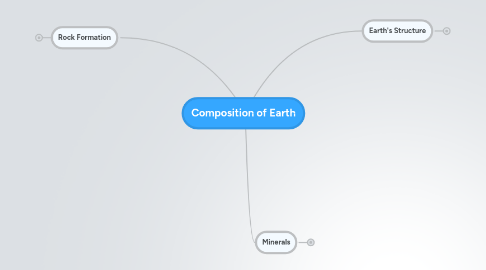
1. Earth's Structure
1.1. 4 layers
1.1.1. Inner Core
1.1.1.1. Deepest layer of the Earth
1.1.1.2. Possibly made of iron and other elements like silicon and carbon
1.1.1.3. A solid ball
1.1.1.4. About 5000-5700 degrees celsius
1.1.2. Outer Core
1.1.2.1. Probably made of liquid iron and nickel
1.1.2.2. Sulphur and oxygen could possibly be present
1.1.2.3. Over 4000 degrees celsius
1.1.3. Mantle
1.1.3.1. Largest layer of the Earth
1.1.3.2. Upper layer of the mantle
1.1.3.2.1. Solid rock
1.1.3.2.2. Approximately 1000 degrees celsius
1.1.3.3. Lower layer of the mantle
1.1.3.3.1. Possibly plastic, like taffy/caramel
1.1.3.3.2. Approximately 2500 degrees celsius
1.1.4. Crust
1.1.4.1. 5 km to 50 km thick
1.1.4.2. On the outside of the Earth
2. Rock Formation
2.1. Igneous Rock
2.1.1. Formed by magma or lava
2.1.1.1. Intrusive Rock
2.1.1.1.1. Formed by cooling magma
2.1.1.2. Extrusive Rock
2.1.1.2.1. Formed by cooling lava
2.2. Sedimentary Rock
2.2.1. From sediment or by chemical reactions
2.2.1.1. Compaction
2.2.1.1.1. Squeezing together layers of sediment
2.2.1.2. Sediment
2.2.1.2.1. Loose material
2.2.1.3. Cementation
2.2.1.3.1. Pieces of rock held together by another material
2.2.2. Often contain fossils
2.2.2.1. Evidence of once living organisms
2.3. Metamorphic Rock
2.3.1. Formed when heat, pressure or fluids change one type of rock into another type (from all three rock types)
2.3.2. Always formed below Earth's surface
2.3.3. Parent Rock
2.3.3.1. Rock that changed into the metamorphic rock
2.3.3.2. Can change into several metamorphic rocks
2.3.4. Foliated
2.3.4.1. Having thin, leaf-like layers
2.3.5. Non-foliated
2.3.5.1. Does not have layers
3. Minerals
3.1. Properties
3.1.1. Structure
3.1.1.1. How the mineral is formed
3.1.2. Hardness
3.1.2.1. How hard it is against scratches
3.1.3. Lustre
3.1.3.1. The reflectiveness
3.1.4. Streak
3.1.4.1. The mark when scraped across a streak plate
3.1.5. Cleavage
3.1.5.1. How it breaks
3.1.6. Colour
3.1.6.1. Is not useful because many minerals are same colour
